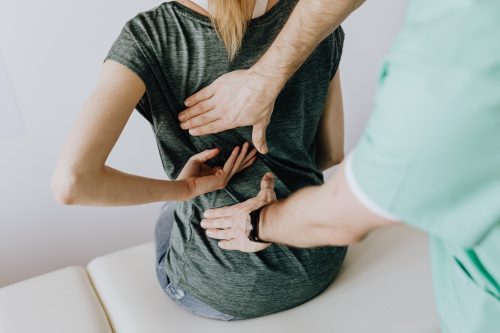
The lumbar spine, which is more commonly referred to as the lower back, comprises of five vertebrae between the pelvis and the ribs, in the lower region of the spine. The narrowing of the spinal canal is known as lumbar spinal stenosis, which compresses the nerves that travel through the lower back and into the legs. While developmental causes may lead to lumbar spinal stenosis (LSS) in younger patients, it is mostly a degenerative condition that affects those 60 or above. The spinal canal narrows slowly, over the course of years or decades. Aging can make the disks less spongy, which reduces disk height and the hardened disk can bulge into the spinal canal.
It can also cause bone spurs and thicken ligaments. All of these eventually narrow the central canal, but there may not be any symptoms. If symptoms do occur, it is mostly because of compression, or inflammation of the nerves, or both. These symptoms include weakness, pain or numbness in the calves, legs, or buttocks, pain radiating into legs or thighs, similar to ‘sciatica’, and cramping in the calves during the walk, meaning frequent short rests when walking a distance. In some rare cases, there may also be loss of normal bladder function or bowel movement, along with loss of functioning of the legs.
The diagnosis for lumbar spinal stenosis is made by a neurosurgeon, based on the physical examination, symptoms, and history, and test results. Imaging studies are used in this process and these can include an X-ray, CT scan or CAT scan, MRI, or a Myelogram. When it comes to the treatment of Lumbar Spinal Stenosis (LSS), there are two different categories that people can explore. They have the option of choosing non-surgical treatments to see if they are effective. If not, they can opt for surgical treatments that are also available. Let’s look at the two options below:
Non-surgical Treatments of LSS
A combination of medications, time, stretching, posture management, and exercise can help many patients in managing flare-ups. There may also be bone-strengthening, nicotine cessation, and weight management endeavors required. Some of the options to explore in this category are:
- Reducing pain and swelling with the use of anti-inflammatory recommendations and using analgesics for relieving pain is the first option that can be explored. Non-prescription medications can be used in most cases for managing the pain, but if the pain is persistent or severe, then prescription medications may be provided.
- Swelling can also be managed by prescribing epidural injections of some medications.
- The mild treatment by Vertos Medical can also be explored, which is a non-invasive and outpatient procedure and can help manage the pain associated with LSS.
- Prescribed exercises or physical therapy can be helpful in protecting and stabilizing the spine, increase flexibility and build endurance. Therapy can also help the patient in resuming normal activities and lifestyles. Usually, four to six weeks of therapy is provided.
Surgical Treatments
If your symptoms are not improved with the use of non-surgical treatments, surgery is then recommended by the doctor. Different types of spinal surgeries can be found and a neurosurgeon will assess the specific case before they determine what kind of procedure may be appropriate. Surgery is usually considered in cases where patients find it difficult to stand or walk and it can impair quality of life, loss of normal bladder/bowel functions, progressive neurological deficits, and physical therapy and medication prove to be ineffective.
Different surgical procedures can be prescribed, depending on the severity of the case, such as decompressive laminectomy, Laminotomy, Foraminotomy, Medial Facetectomy, Anterior Lumbar Interbody Fusion (ALIF), and Posterior Lumbar Interbody Fusion (PLIF).
Interesting Related Article: “Highlighting Importance Of Investing In A Quality Office Chair“

